Downcity Motors: A Case Study on Business Ethics and Social Media Use
VerifiedAdded on 2023/06/05
|10
|2494
|267
Case Study
AI Summary
This case study examines the ethical challenges faced by Downcity Motors regarding an employee's disparaging social media comments. It explores alternative solutions, including disciplinary action, termination, and communication, while considering the ethical implications of each approach. The analysis incorporates the National Labor Relations Act and emphasizes the importance of a clear social media policy. Recommendations focus on open communication with the employee to address concerns and prevent future ethical dilemmas. The study underscores the need for organizations to prioritize business ethics and stakeholder needs to ensure sustainable business practices and protect the company's reputation. Desklib provides a platform for students to access similar case studies and solved assignments.
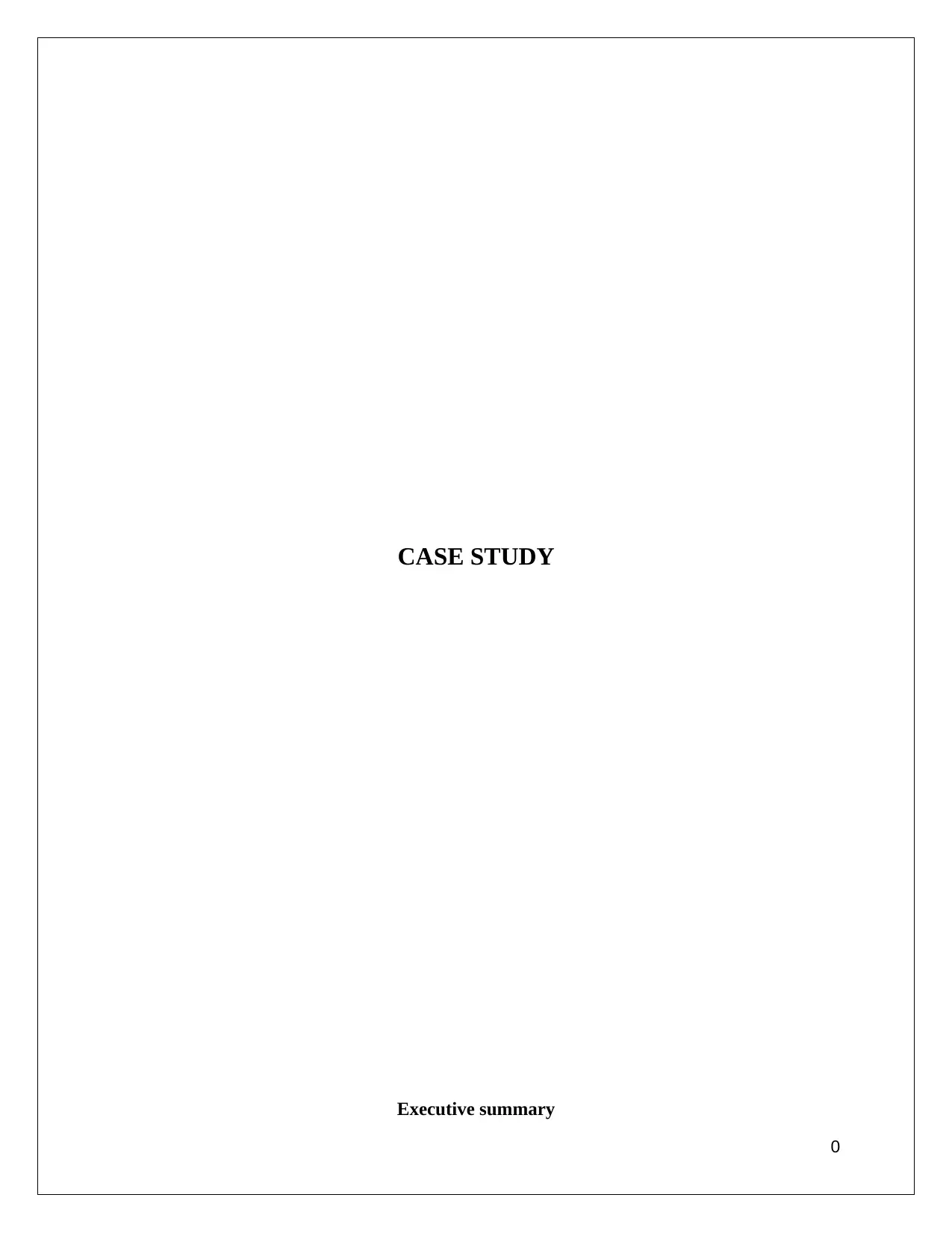
CASE STUDY
Executive summary
0
Executive summary
0
Paraphrase This Document
Need a fresh take? Get an instant paraphrase of this document with our AI Paraphraser
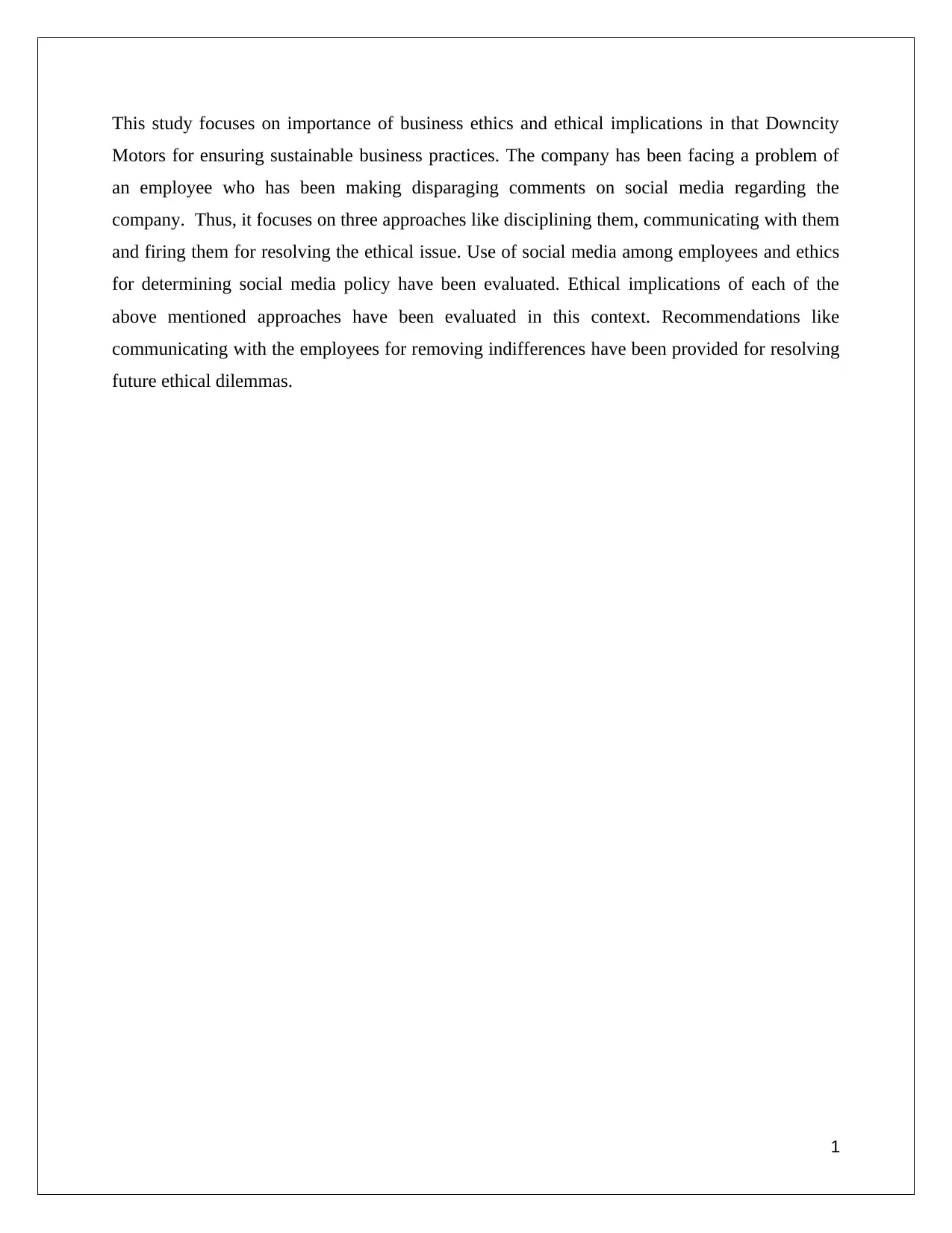
This study focuses on importance of business ethics and ethical implications in that Downcity
Motors for ensuring sustainable business practices. The company has been facing a problem of
an employee who has been making disparaging comments on social media regarding the
company. Thus, it focuses on three approaches like disciplining them, communicating with them
and firing them for resolving the ethical issue. Use of social media among employees and ethics
for determining social media policy have been evaluated. Ethical implications of each of the
above mentioned approaches have been evaluated in this context. Recommendations like
communicating with the employees for removing indifferences have been provided for resolving
future ethical dilemmas.
1
Motors for ensuring sustainable business practices. The company has been facing a problem of
an employee who has been making disparaging comments on social media regarding the
company. Thus, it focuses on three approaches like disciplining them, communicating with them
and firing them for resolving the ethical issue. Use of social media among employees and ethics
for determining social media policy have been evaluated. Ethical implications of each of the
above mentioned approaches have been evaluated in this context. Recommendations like
communicating with the employees for removing indifferences have been provided for resolving
future ethical dilemmas.
1
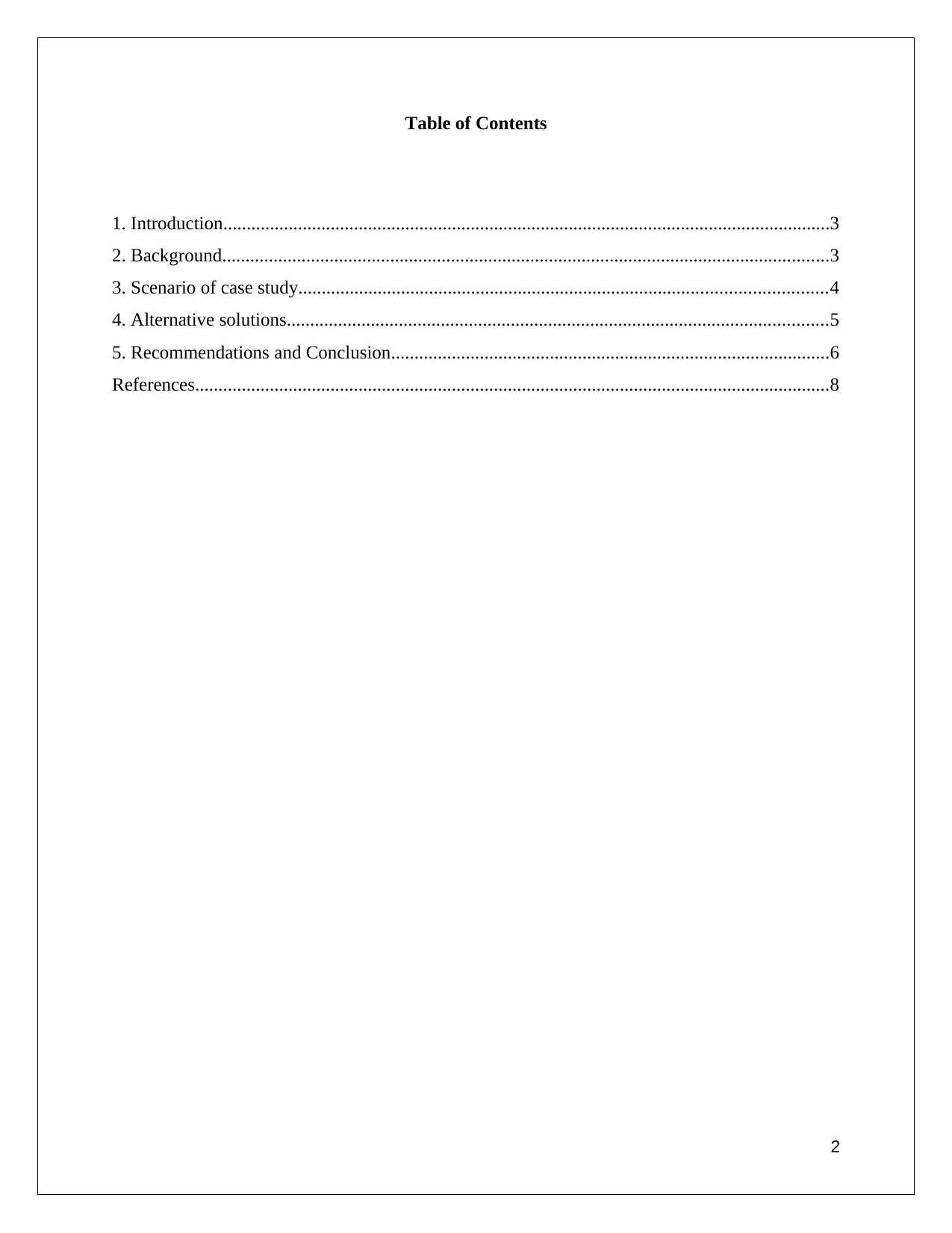
Table of Contents
1. Introduction..................................................................................................................................3
2. Background..................................................................................................................................3
3. Scenario of case study.................................................................................................................4
4. Alternative solutions....................................................................................................................5
5. Recommendations and Conclusion..............................................................................................6
References........................................................................................................................................8
2
1. Introduction..................................................................................................................................3
2. Background..................................................................................................................................3
3. Scenario of case study.................................................................................................................4
4. Alternative solutions....................................................................................................................5
5. Recommendations and Conclusion..............................................................................................6
References........................................................................................................................................8
2
⊘ This is a preview!⊘
Do you want full access?
Subscribe today to unlock all pages.

Trusted by 1+ million students worldwide

1. Introduction
It is very important for organizations to implement business ethics for creating brand value and
customer loyalty. Business ethics ensures that organizations adhere to the needs of its
stakeholders and devise the necessary strategies for organizational progress and development.
This study focuses on the importance of business ethics that Downcity Motors need to implement
for ensuring sustainable business practices. The company has been facing a problem of an
employee who has been making disparaging comments on social media regarding the company.
It needs to consider ethical principles for resolving this issue.
As the employee has a good performance record and the company does not have any policy
regarding social media, so it is facing ethical dilemma of whether to discipline him or fire him. It
needs to explore all the possible interventions and strategies that can be adopted for resolving
this ethical issue. This study focuses on two approaches like disciplining them and firing them
for resolving the ethical issue. Use of social media among employees and ethics for determining
social media policy have been evaluated. The ethical implications of each of the approaches have
been evaluated in this context. In this case, National Labour Relations Act 1935 has been
focussed on for understanding the rights of employees. Recommendations for the most
appropriate solution have been provided so that the company is able to resolve future ethical
dilemmas.
2. Background
Over the last years, social media has been cemented in our culture and people are using in every
aspect of life for gaining benefits. Trevino & Nelson (2016, p.10) stated that it has many
advantages like recruiting employees, gaining knowledge of working procedures of companies
and understanding the demands of emerging market. However, some organizations perceive
social media as the waste of time and energy (Trainor et al. 2014, p.1207). This leads to
organizations discouraging usage of social media in the workplace or banning it altogether.
Social media has certain disadvantages like posting any message on social media gets spread
instantly and it is nearly impossible to change the message once given. People have the habit of
believing whatever information or message they get on social media (Brown & Duguid, 2017).
3
It is very important for organizations to implement business ethics for creating brand value and
customer loyalty. Business ethics ensures that organizations adhere to the needs of its
stakeholders and devise the necessary strategies for organizational progress and development.
This study focuses on the importance of business ethics that Downcity Motors need to implement
for ensuring sustainable business practices. The company has been facing a problem of an
employee who has been making disparaging comments on social media regarding the company.
It needs to consider ethical principles for resolving this issue.
As the employee has a good performance record and the company does not have any policy
regarding social media, so it is facing ethical dilemma of whether to discipline him or fire him. It
needs to explore all the possible interventions and strategies that can be adopted for resolving
this ethical issue. This study focuses on two approaches like disciplining them and firing them
for resolving the ethical issue. Use of social media among employees and ethics for determining
social media policy have been evaluated. The ethical implications of each of the approaches have
been evaluated in this context. In this case, National Labour Relations Act 1935 has been
focussed on for understanding the rights of employees. Recommendations for the most
appropriate solution have been provided so that the company is able to resolve future ethical
dilemmas.
2. Background
Over the last years, social media has been cemented in our culture and people are using in every
aspect of life for gaining benefits. Trevino & Nelson (2016, p.10) stated that it has many
advantages like recruiting employees, gaining knowledge of working procedures of companies
and understanding the demands of emerging market. However, some organizations perceive
social media as the waste of time and energy (Trainor et al. 2014, p.1207). This leads to
organizations discouraging usage of social media in the workplace or banning it altogether.
Social media has certain disadvantages like posting any message on social media gets spread
instantly and it is nearly impossible to change the message once given. People have the habit of
believing whatever information or message they get on social media (Brown & Duguid, 2017).
3
Paraphrase This Document
Need a fresh take? Get an instant paraphrase of this document with our AI Paraphraser

Social media has the ability to create the false impression among people as they are more
dependent on it than any other sources of information.
It is therefore advised that personal use of social media by the employees need to be managed by
Quarshie, Salmi & Leuschner (2016, p.90) argued that using the principles which have been used
for inappropriate behavior or misconduct. However, organizations should not consider
terminating an employee or taking disciplinary action against an employee without considering
the right reason for justifying the action (DesJardins, 2014, p.56). It has been said that employees
using social media outside working hours can have a negative impact on employment which can
be seen as a breach of employment (Michaelson et al. 2014, p.80). This gives the organizations
guidance on the situation when the employer or the company can terminate an employee while
conducting outside working hours. It has been found that the comments that have been made on
social media by an employee that can mar the image of the company can be a valid basis for
termination. Beck (2017) commented that posting comments on social media against an
employer or a company which is seen by a large number of people is not a private but rather a
public comment. It will be foolish for the employees to think that whatever they are posting on
Facebook has total immunity from results.
3. The scenario of the case study
In the case study, Kenton, an employee of reputed firm Downcity, has been found of making
disparaging comments on social media regarding other company twice. In the first time, the
employee has been let out as he was told that he has been sharing the pictures with his friends
and family. Weiss (2014, p.11) is of the view that the management can ask e4mployees to refrain
from posting such comments which can harm the image of their companies. In this case, he has
made some disparaging comments regarding the strategic position of the company. As Kenton
has a good performance record and has helped in increasing sales of the company, employers are
in cross heads whether to give him a warning or fire him. Dell is of the opinion to fire him while
Tyson is in the favour of giving warning to him. However, Susannah is in a dilemma whether to
fire him or give him a warning. As the company has no such policies on social media, Susannah
is worried about what needs to be done so that it does not hamper image of the company. In this
case, Susannah can think that Kenton has done this out of sarcasm and should try to talk to him
for understanding his problem, instead of giving disparaging comments on social media.
4
dependent on it than any other sources of information.
It is therefore advised that personal use of social media by the employees need to be managed by
Quarshie, Salmi & Leuschner (2016, p.90) argued that using the principles which have been used
for inappropriate behavior or misconduct. However, organizations should not consider
terminating an employee or taking disciplinary action against an employee without considering
the right reason for justifying the action (DesJardins, 2014, p.56). It has been said that employees
using social media outside working hours can have a negative impact on employment which can
be seen as a breach of employment (Michaelson et al. 2014, p.80). This gives the organizations
guidance on the situation when the employer or the company can terminate an employee while
conducting outside working hours. It has been found that the comments that have been made on
social media by an employee that can mar the image of the company can be a valid basis for
termination. Beck (2017) commented that posting comments on social media against an
employer or a company which is seen by a large number of people is not a private but rather a
public comment. It will be foolish for the employees to think that whatever they are posting on
Facebook has total immunity from results.
3. The scenario of the case study
In the case study, Kenton, an employee of reputed firm Downcity, has been found of making
disparaging comments on social media regarding other company twice. In the first time, the
employee has been let out as he was told that he has been sharing the pictures with his friends
and family. Weiss (2014, p.11) is of the view that the management can ask e4mployees to refrain
from posting such comments which can harm the image of their companies. In this case, he has
made some disparaging comments regarding the strategic position of the company. As Kenton
has a good performance record and has helped in increasing sales of the company, employers are
in cross heads whether to give him a warning or fire him. Dell is of the opinion to fire him while
Tyson is in the favour of giving warning to him. However, Susannah is in a dilemma whether to
fire him or give him a warning. As the company has no such policies on social media, Susannah
is worried about what needs to be done so that it does not hamper image of the company. In this
case, Susannah can think that Kenton has done this out of sarcasm and should try to talk to him
for understanding his problem, instead of giving disparaging comments on social media.
4
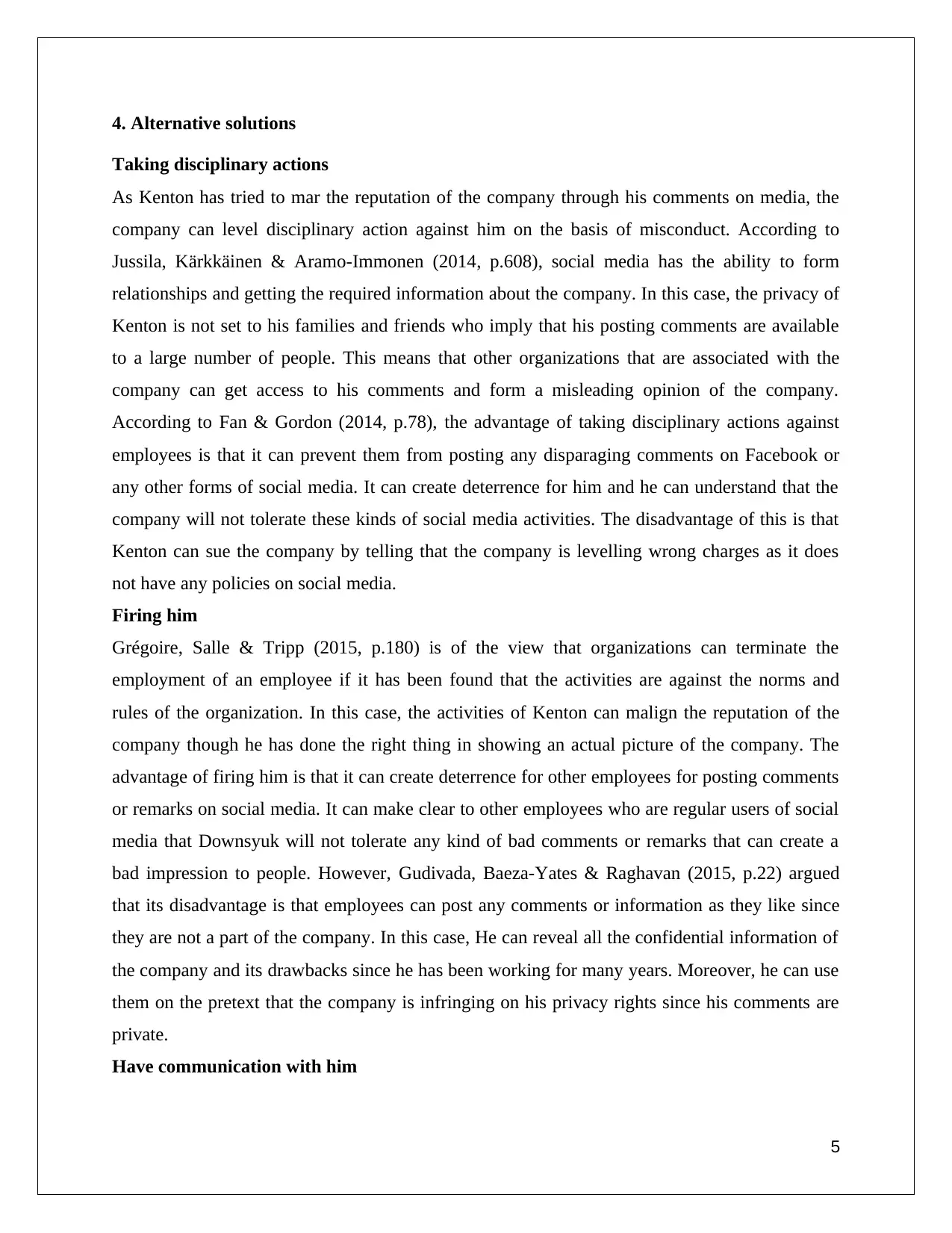
4. Alternative solutions
Taking disciplinary actions
As Kenton has tried to mar the reputation of the company through his comments on media, the
company can level disciplinary action against him on the basis of misconduct. According to
Jussila, Kärkkäinen & Aramo-Immonen (2014, p.608), social media has the ability to form
relationships and getting the required information about the company. In this case, the privacy of
Kenton is not set to his families and friends who imply that his posting comments are available
to a large number of people. This means that other organizations that are associated with the
company can get access to his comments and form a misleading opinion of the company.
According to Fan & Gordon (2014, p.78), the advantage of taking disciplinary actions against
employees is that it can prevent them from posting any disparaging comments on Facebook or
any other forms of social media. It can create deterrence for him and he can understand that the
company will not tolerate these kinds of social media activities. The disadvantage of this is that
Kenton can sue the company by telling that the company is levelling wrong charges as it does
not have any policies on social media.
Firing him
Grégoire, Salle & Tripp (2015, p.180) is of the view that organizations can terminate the
employment of an employee if it has been found that the activities are against the norms and
rules of the organization. In this case, the activities of Kenton can malign the reputation of the
company though he has done the right thing in showing an actual picture of the company. The
advantage of firing him is that it can create deterrence for other employees for posting comments
or remarks on social media. It can make clear to other employees who are regular users of social
media that Downsyuk will not tolerate any kind of bad comments or remarks that can create a
bad impression to people. However, Gudivada, Baeza-Yates & Raghavan (2015, p.22) argued
that its disadvantage is that employees can post any comments or information as they like since
they are not a part of the company. In this case, He can reveal all the confidential information of
the company and its drawbacks since he has been working for many years. Moreover, he can use
them on the pretext that the company is infringing on his privacy rights since his comments are
private.
Have communication with him
5
Taking disciplinary actions
As Kenton has tried to mar the reputation of the company through his comments on media, the
company can level disciplinary action against him on the basis of misconduct. According to
Jussila, Kärkkäinen & Aramo-Immonen (2014, p.608), social media has the ability to form
relationships and getting the required information about the company. In this case, the privacy of
Kenton is not set to his families and friends who imply that his posting comments are available
to a large number of people. This means that other organizations that are associated with the
company can get access to his comments and form a misleading opinion of the company.
According to Fan & Gordon (2014, p.78), the advantage of taking disciplinary actions against
employees is that it can prevent them from posting any disparaging comments on Facebook or
any other forms of social media. It can create deterrence for him and he can understand that the
company will not tolerate these kinds of social media activities. The disadvantage of this is that
Kenton can sue the company by telling that the company is levelling wrong charges as it does
not have any policies on social media.
Firing him
Grégoire, Salle & Tripp (2015, p.180) is of the view that organizations can terminate the
employment of an employee if it has been found that the activities are against the norms and
rules of the organization. In this case, the activities of Kenton can malign the reputation of the
company though he has done the right thing in showing an actual picture of the company. The
advantage of firing him is that it can create deterrence for other employees for posting comments
or remarks on social media. It can make clear to other employees who are regular users of social
media that Downsyuk will not tolerate any kind of bad comments or remarks that can create a
bad impression to people. However, Gudivada, Baeza-Yates & Raghavan (2015, p.22) argued
that its disadvantage is that employees can post any comments or information as they like since
they are not a part of the company. In this case, He can reveal all the confidential information of
the company and its drawbacks since he has been working for many years. Moreover, he can use
them on the pretext that the company is infringing on his privacy rights since his comments are
private.
Have communication with him
5
⊘ This is a preview!⊘
Do you want full access?
Subscribe today to unlock all pages.

Trusted by 1+ million students worldwide

The third option, which is available in resolving this issue, is having communication with him
regarding his problems, strategic problems of the company and ways it can be dealt with.
Paniagua & Sapena (2014) commented that effective communication can help in understanding
the problems of employees and resolving them for enhancing organizational productivity. The
advantage of this communication is that it can help the company to understand the strategic
problems and devise strategies as required. It can prevent him from making any types of
disparaging comments on social media. Kenton will feel that the company pays heed to his
information and is concerned with his ideas and knowledge. Holt (2016, p.49) argued that its
disadvantage is that it can give a lenient picture of the companies encouraging social media
activities. It can make Kenton feel that he the right to make any type of comments as he wishes
on social media.
5. Recommendations and Conclusion
It can be recommended that the company should have effective communication with Kenton in
order to know his issues regarding the company instead of writing it online. Effective
communication will help him to reach the management directly if he wants to do things
differently. The management needs to make Kenton understand that they do not want him to
publish things which can mar the reputation or brand image of the company. They required
listening to the advice and suggestion given by Kenton so that he does not feel that the company
has an indifferent attitude towards him. It is required for the management to upgrade its policies
regarding social media so that no other employees can post comments as they like. As per
Business ethics theory, it is required for the management to give importance to the needs of
stakeholders as they have a direct influence on operations of the company. It should implement
the guidelines of the National Labour relations Act 1935 so as to understand the rights of
employees.
It can be concluded that organizations need to apply business ethics for resolving ethical issues
pertaining to the activities of employees. Organizations should have clear policies and
procedures which can create deterrence for employees to do any activities which can damage the
reputation of the company. In this case, Kenton has posted some comments on social media
which have not gone well with the management of Downcity Motors. The management can
explore options like taking disciplinary action, firing the employees or talking with him for
6
regarding his problems, strategic problems of the company and ways it can be dealt with.
Paniagua & Sapena (2014) commented that effective communication can help in understanding
the problems of employees and resolving them for enhancing organizational productivity. The
advantage of this communication is that it can help the company to understand the strategic
problems and devise strategies as required. It can prevent him from making any types of
disparaging comments on social media. Kenton will feel that the company pays heed to his
information and is concerned with his ideas and knowledge. Holt (2016, p.49) argued that its
disadvantage is that it can give a lenient picture of the companies encouraging social media
activities. It can make Kenton feel that he the right to make any type of comments as he wishes
on social media.
5. Recommendations and Conclusion
It can be recommended that the company should have effective communication with Kenton in
order to know his issues regarding the company instead of writing it online. Effective
communication will help him to reach the management directly if he wants to do things
differently. The management needs to make Kenton understand that they do not want him to
publish things which can mar the reputation or brand image of the company. They required
listening to the advice and suggestion given by Kenton so that he does not feel that the company
has an indifferent attitude towards him. It is required for the management to upgrade its policies
regarding social media so that no other employees can post comments as they like. As per
Business ethics theory, it is required for the management to give importance to the needs of
stakeholders as they have a direct influence on operations of the company. It should implement
the guidelines of the National Labour relations Act 1935 so as to understand the rights of
employees.
It can be concluded that organizations need to apply business ethics for resolving ethical issues
pertaining to the activities of employees. Organizations should have clear policies and
procedures which can create deterrence for employees to do any activities which can damage the
reputation of the company. In this case, Kenton has posted some comments on social media
which have not gone well with the management of Downcity Motors. The management can
explore options like taking disciplinary action, firing the employees or talking with him for
6
Paraphrase This Document
Need a fresh take? Get an instant paraphrase of this document with our AI Paraphraser
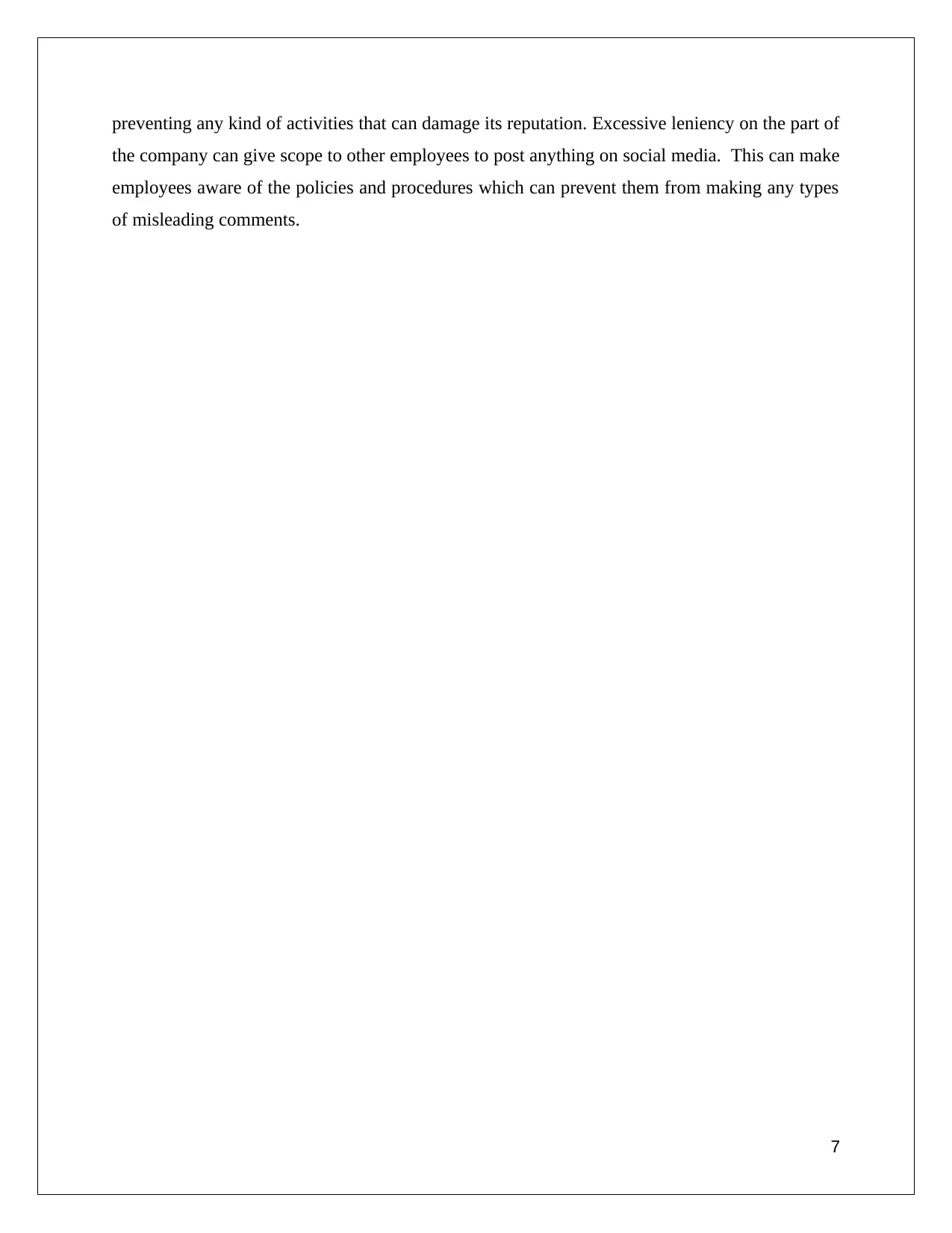
preventing any kind of activities that can damage its reputation. Excessive leniency on the part of
the company can give scope to other employees to post anything on social media. This can make
employees aware of the policies and procedures which can prevent them from making any types
of misleading comments.
7
the company can give scope to other employees to post anything on social media. This can make
employees aware of the policies and procedures which can prevent them from making any types
of misleading comments.
7
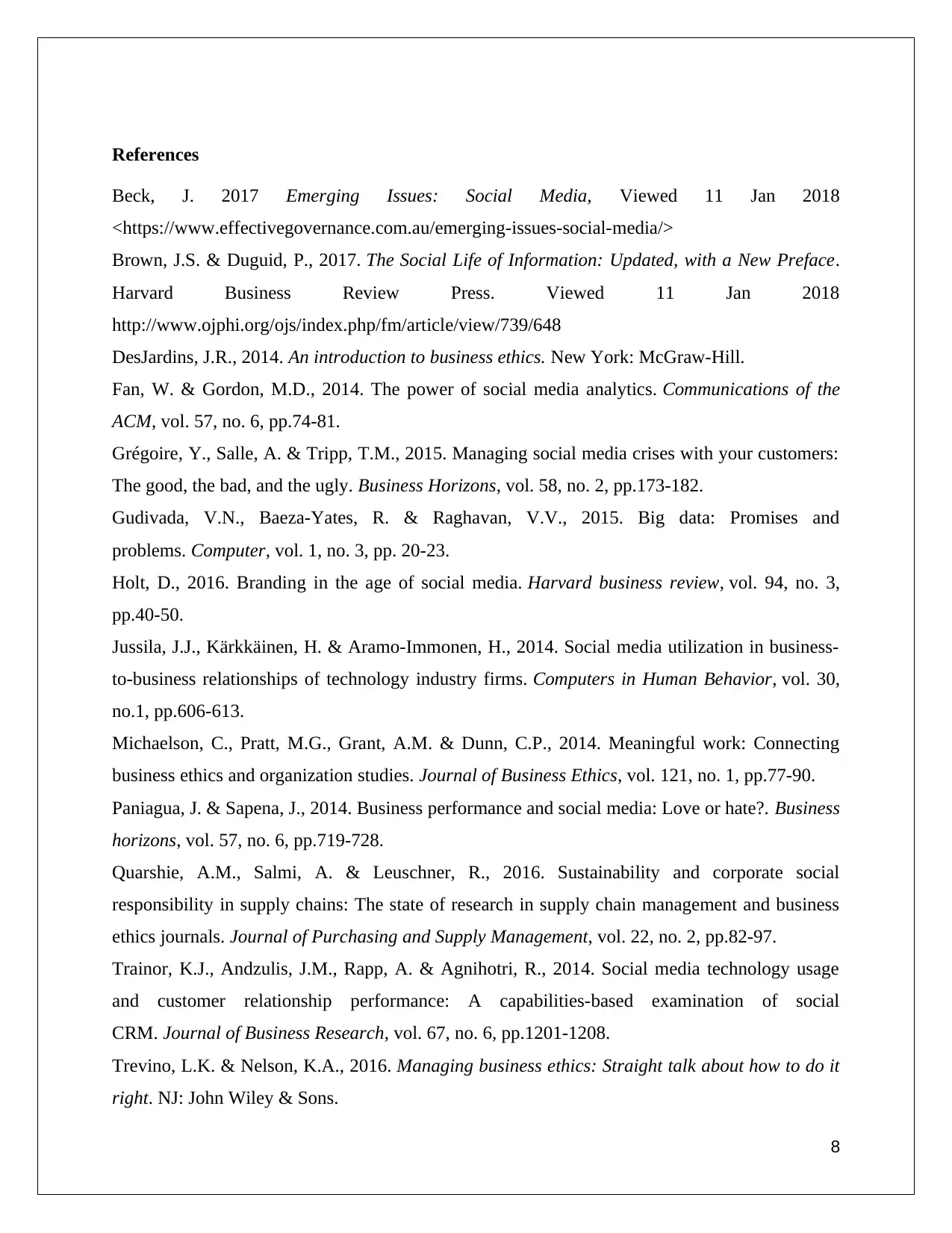
References
Beck, J. 2017 Emerging Issues: Social Media, Viewed 11 Jan 2018
<https://www.effectivegovernance.com.au/emerging-issues-social-media/>
Brown, J.S. & Duguid, P., 2017. The Social Life of Information: Updated, with a New Preface.
Harvard Business Review Press. Viewed 11 Jan 2018
http://www.ojphi.org/ojs/index.php/fm/article/view/739/648
DesJardins, J.R., 2014. An introduction to business ethics. New York: McGraw-Hill.
Fan, W. & Gordon, M.D., 2014. The power of social media analytics. Communications of the
ACM, vol. 57, no. 6, pp.74-81.
Grégoire, Y., Salle, A. & Tripp, T.M., 2015. Managing social media crises with your customers:
The good, the bad, and the ugly. Business Horizons, vol. 58, no. 2, pp.173-182.
Gudivada, V.N., Baeza-Yates, R. & Raghavan, V.V., 2015. Big data: Promises and
problems. Computer, vol. 1, no. 3, pp. 20-23.
Holt, D., 2016. Branding in the age of social media. Harvard business review, vol. 94, no. 3,
pp.40-50.
Jussila, J.J., Kärkkäinen, H. & Aramo-Immonen, H., 2014. Social media utilization in business-
to-business relationships of technology industry firms. Computers in Human Behavior, vol. 30,
no.1, pp.606-613.
Michaelson, C., Pratt, M.G., Grant, A.M. & Dunn, C.P., 2014. Meaningful work: Connecting
business ethics and organization studies. Journal of Business Ethics, vol. 121, no. 1, pp.77-90.
Paniagua, J. & Sapena, J., 2014. Business performance and social media: Love or hate?. Business
horizons, vol. 57, no. 6, pp.719-728.
Quarshie, A.M., Salmi, A. & Leuschner, R., 2016. Sustainability and corporate social
responsibility in supply chains: The state of research in supply chain management and business
ethics journals. Journal of Purchasing and Supply Management, vol. 22, no. 2, pp.82-97.
Trainor, K.J., Andzulis, J.M., Rapp, A. & Agnihotri, R., 2014. Social media technology usage
and customer relationship performance: A capabilities-based examination of social
CRM. Journal of Business Research, vol. 67, no. 6, pp.1201-1208.
Trevino, L.K. & Nelson, K.A., 2016. Managing business ethics: Straight talk about how to do it
right. NJ: John Wiley & Sons.
8
Beck, J. 2017 Emerging Issues: Social Media, Viewed 11 Jan 2018
<https://www.effectivegovernance.com.au/emerging-issues-social-media/>
Brown, J.S. & Duguid, P., 2017. The Social Life of Information: Updated, with a New Preface.
Harvard Business Review Press. Viewed 11 Jan 2018
http://www.ojphi.org/ojs/index.php/fm/article/view/739/648
DesJardins, J.R., 2014. An introduction to business ethics. New York: McGraw-Hill.
Fan, W. & Gordon, M.D., 2014. The power of social media analytics. Communications of the
ACM, vol. 57, no. 6, pp.74-81.
Grégoire, Y., Salle, A. & Tripp, T.M., 2015. Managing social media crises with your customers:
The good, the bad, and the ugly. Business Horizons, vol. 58, no. 2, pp.173-182.
Gudivada, V.N., Baeza-Yates, R. & Raghavan, V.V., 2015. Big data: Promises and
problems. Computer, vol. 1, no. 3, pp. 20-23.
Holt, D., 2016. Branding in the age of social media. Harvard business review, vol. 94, no. 3,
pp.40-50.
Jussila, J.J., Kärkkäinen, H. & Aramo-Immonen, H., 2014. Social media utilization in business-
to-business relationships of technology industry firms. Computers in Human Behavior, vol. 30,
no.1, pp.606-613.
Michaelson, C., Pratt, M.G., Grant, A.M. & Dunn, C.P., 2014. Meaningful work: Connecting
business ethics and organization studies. Journal of Business Ethics, vol. 121, no. 1, pp.77-90.
Paniagua, J. & Sapena, J., 2014. Business performance and social media: Love or hate?. Business
horizons, vol. 57, no. 6, pp.719-728.
Quarshie, A.M., Salmi, A. & Leuschner, R., 2016. Sustainability and corporate social
responsibility in supply chains: The state of research in supply chain management and business
ethics journals. Journal of Purchasing and Supply Management, vol. 22, no. 2, pp.82-97.
Trainor, K.J., Andzulis, J.M., Rapp, A. & Agnihotri, R., 2014. Social media technology usage
and customer relationship performance: A capabilities-based examination of social
CRM. Journal of Business Research, vol. 67, no. 6, pp.1201-1208.
Trevino, L.K. & Nelson, K.A., 2016. Managing business ethics: Straight talk about how to do it
right. NJ: John Wiley & Sons.
8
⊘ This is a preview!⊘
Do you want full access?
Subscribe today to unlock all pages.

Trusted by 1+ million students worldwide
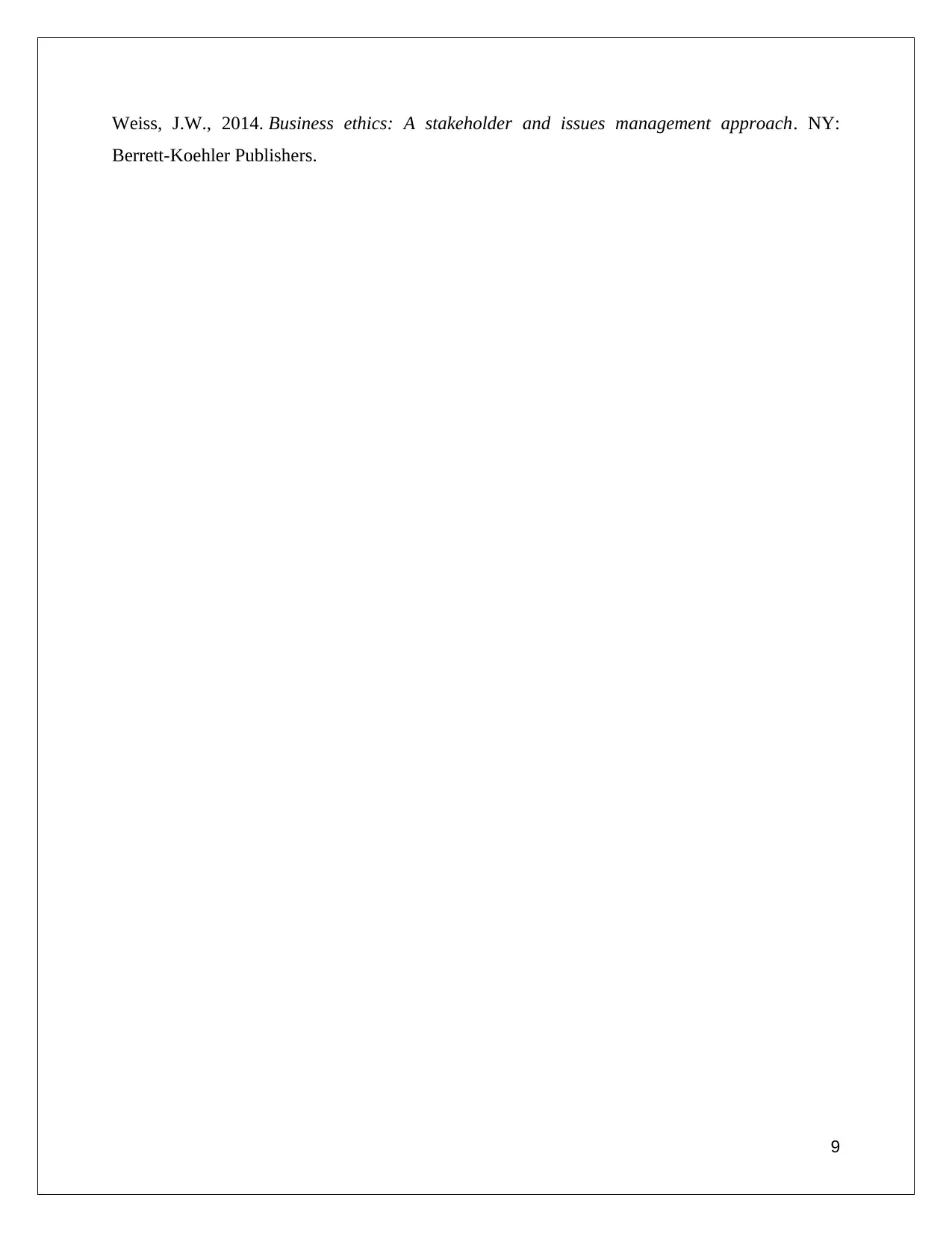
Weiss, J.W., 2014. Business ethics: A stakeholder and issues management approach. NY:
Berrett-Koehler Publishers.
9
Berrett-Koehler Publishers.
9
1 out of 10
Related Documents
Your All-in-One AI-Powered Toolkit for Academic Success.
+13062052269
info@desklib.com
Available 24*7 on WhatsApp / Email
![[object Object]](/_next/static/media/star-bottom.7253800d.svg)
Unlock your academic potential
Copyright © 2020–2025 A2Z Services. All Rights Reserved. Developed and managed by ZUCOL.





